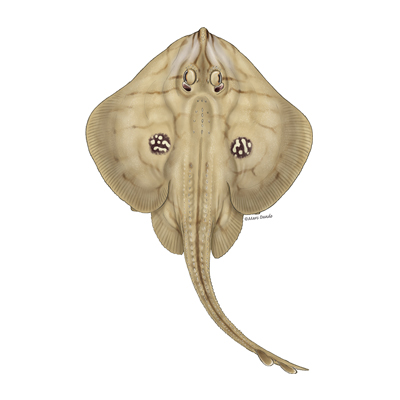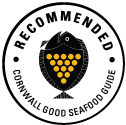

Cuckoo rays are a relatively small sized ray belonging to the skate family and are often marketed simply as skate wings. They are identified by 2 large, dark, false eyespots their sandy coloured back. They havea rough upper skin with large skin teeth along the tail. The cuckoo ray is one of 5 similar Rajid skate species found in our waters. Identification of rays is not easy so ray landing records are not usually accurately broken down to species level.
Skates and rays are slow growing, late maturing and lay a small number of eggs per year so are vulnerable to fishing pressure. This species is not actively targeted but significant quantities are caught as bycatch in trawl and net fisheries. Recent advice published by ICES shows that this species is doing well in UK waters and that stocks are healthy. Management (a mixed species quota) is poor for rays. If you choose to buy skate be aware that when they have been skinned it is impossible to tell which species you are buying so please be careful and ask to see the ray before it is skinned to ensure you are not buying an unsustainable ray.
86 tonnes of Cuckoo ray were landed to Cornish ports in 2021 with a value of £75k. (MMO landings data)
Updated July 2023

West of Scotland, Southern Celtic Sea, Western English Channel and Bay of Biscay (6, 7, 8a, 8b, 8d)
Caught using heavy beam trawl nets that are dragged over the seabed.
Learn more
West of Scotland, Southern Celtic Sea, Western English Channel and Bay of Biscay (6, 7, 8a, 8b, 8d)
Caught using monofilament nets set on the seabed
Learn more
West of Scotland, Southern Celtic Sea, Western English Channel and Bay of Biscay (6, 7, 8a, 8b, 8d)
A large trawl held open by paravane trawl doors, the open net is then pulled along in contact with the seabed.
Learn moreCornwall Good Seafood Guide rates fish on sustainability using a scale of 1 to 5.
1, 2 and 3 are recommended, Fish to avoid are rated 5.
We use the system devised by the Marine Conservation Society (MCS) so our scores are comparable with the scores produced by MCS for the UK and fisheries from all around the world. For more information on scoring click here.
A medium sized ray growing to a maximum length of 75cm. Cuckoo rays reach maturity at a length of around 60cm and an age of 4 to 5 years. They lay between 70 and 150 eggs per year. They are most commonly found at depths of 200m on sandy and muddy seabeds. They are found in shallower areas but the juveniles seem to prefer to spend their time in deep water.






Cornwall Good Seafood Guide is underpinned by the Marine Conservation Society (MCS) Good Fish Guide. The first UK consumer guide to sustainable seafood. For more information visit www.fishonline.org
Cornwall Good Seafood Guide is here to help us all make sustainable seafood choices. Choices that will help us keep the oceans healthy and Cornish fishers' futures safe. This website is funded by Cornwall Wildlife Trust. If you would like to make a meaningful difference to the health of our oceans, please consider making a donation to the Cornwall Wildlife Trust Ocean Emergency fund. Your donation will help safeguard these remarkable environments, ensuring that they continue to thrive for generations to come. Together, we can be stewards of the seas and champions for a healthier, more sustainable future.